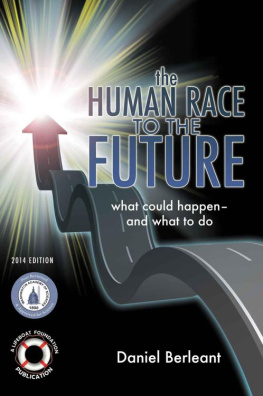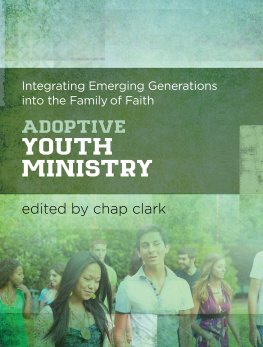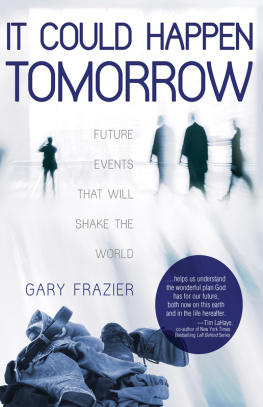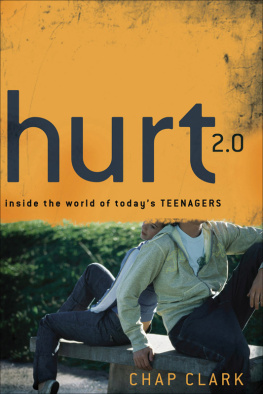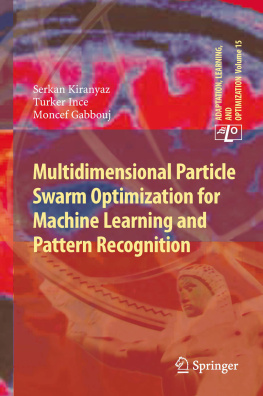Praisefor
The Human Race to the Future
The 21st Century will almost certainly see moretechnological change than any century before. The computer scientist DanielBerleant offers a concise, readable guide to what might come next, filled withspecific recommendations on what we all need to do to prepare.
Gary Marcus, PhD, New York University; best-sellingauthor of Guitar Zero ; author ofarticles in Wired , Science , Nature , and other major popular periodicals and scholarlyjournals
I read through much of the book while teaching forthe International Space University in Australia. It is a thought-provokingenterprise of the first order.
Joseph N. Pelton, PhD, Director of the Space andAdvanced Communications Research Institute (SACRI) at George WashingtonUniversity; founder and Vice Chairman, Arthur C. Clarke Foundation; Pulitzer Prize nominee
Berleant takes the reader on an elegantly written,thought provoking ride that could inspire high school students to be morecreative, their parents and grandparents to be more future aware, and leadersof nations around the world to take heed and act.
Donald Maclean, MBChB, retired family physician, psychiatrist, and founding department chair at theUniversity of Illinois
_____________________
A clear alternative to Weschs The end of wonder in the age of whatever the reader willshare the excitement and joy of this integration of futurism and popularscience. According to the author, My goal is a view of the future at a rangeof topics and time scales, based on a foundation of science. In meldingfuturism and popular science, I have worked to illuminate the significance andthe beauty of that synergy.
_____________________
The HumanRace to the Future is awonderful, comprehensive and timely contribution to the MUST READ literature onexistential risk.
Roman V.Yampolskiy, Director, Cybersecurity Laboratory, University of Louisville; authorof six books
As a technology futurist I am extremely interested inthe topics of this book. Thank you so much for writing this excellent book!!
Elina Hiltunen, PhD, CEO and f ounder of Whats NextConsulting Oy (Finland); author of book TravelGuide to the Future ( Matkaopas tulevaisuuteen )
Daniel Berleant whizzes past the future and thenloops back to look it in the eye. This is a brilliant book.
Sabiha RumaniMalik, President of Sanghata Global; winner of the 2013 Ashoka U-Cordes Awardfor Impact, Innovation and Potential for Replicability
I have been pleasantly surprised at the quality anddepth of the material in this book.
Luke Hutchison, PhD (MIT), Google; TED fellow; Singularity University alumnus
_____________________
Although manyforesight and futurism books belong in the science fiction section, Berleantgrounds his writing in scientific facts and knowledge, while maintaining theexcitement the material deserves. the book canexpand your view of the possible.
rd Square (www.33rdsquare.com)
.
The Human Race to the Future What Could Happen and What to Do Daniel Berleant A Lifeboat Foundation Book |
Published by theLifeboat Foundation
lifeboat.com
Copyright 2013, 2014 by Daniel Berleant
All rights reserved . For permissions contact the publisher or author.
Distributor and translatorinquiries welcome.
Spiral clock coverdesign: Catherine Asaro
Clock art: Francesco De Comit 2007
( see his site at www.lifl.fr/~decomite )
Circuit board clock, highway, & retroscope covers:Jason Batt
Alien landscapecover: Frank D. Smith
2014 edition (first edition May, 2013)
Manufactured in theUnited States of America
9 11 13 15 16 14 12 10
Library of CongressMotivated Cataloging Data:
Berleant, Daniel .
The human race to the future : what could happen and what to do /
Daniel Berleant. 2014 ed.
p. cm.
1. Scienceforecasting. 2. Technologyforesight.
3. Science and technologysocial aspects. I. Title.
Includesbibliographic references and index
QA175.5.B394 2014

This scientific society uses peer review to determine which worksmeet scientific standards. Visit the Washington Academy of Sciences atwashacadsci.org.
To Joy and Our NextGeneration
Table of Contents
Foreword ( 3 Pages )
omments byGil Alterovitz and Brandon H. Lee
Introduction ( 7 Pages )
hy Read This Book?
Who doesnt have at least some curiosityabout the future what things will belike one day? This book suggests some answers, spanning from the current centurynearly to eternity itself. This book is for you if you are interested in thefuture, intrigued by science and technology, or both.
The First Generation:
The Next Hundred Years
Chapter One (4 Pages )
hat It Means That an Hours Work Yields a WeeksFood
Labor productivityis so high we could all live comfortably working much less than we currentlydo. What does this mean? Will we work fewer hours in the future than we do now?
Chapter Two (5 Pages )
ive Anywhere, WorkAnywhere Else
Current commuting and living practices continue inpart because were used to doing it that way. These habits are ripe for change.The economic incentives favor telecommuting and robotic telepresence. Hereis what the insistent push of these incentives means for the future of living,working, and commuting.
Chapter Three (6 Pages )
eyboardsYesterday,
Mind Reading Tomorrow
Keyboards are the classic way to interact with computers. However, general use computersthat interact directly with the electrical activity of the brain are gettingcloser with each passing year.
Chapter Four (6 Pages )
iki-Wiki-Wikipedia
Wiki-wikipedia, an extension toWikipedia, could provide a view of any article from the colored lens of any other article automatically. Yet the shortpassage concept demonstrated a hundred years ago by Paul Otlets Mundaneumcould extend Wikipedia even further, from Wiki-wikipedia to Wiki-wiki-wikipedia.
Chapter Five (7 Pages )
mart Pillsn Such:Cognitive Enhancement the Easy Way
The ancient Greeks used honey water (which they called hydromel) to enhance mental performance.Modern society presents other possibilities, from pharmaceuticals to deep brainstimulation. The future will provide more. Caveat emptor .
Chapter Six (14 Pages )
rom HighlyCentralized to Highly Decentralized Society
Modern civilization depends on centralized food and energy production, and the resultantrequired distribution networks. This is risky, even dangerous. In the future,gardening and farming robots could mitigate the risks of the food distributionsystem, and solar energy could mitigate the risks of centralized electricutilities. Society will be much more resilient to disaster as a result.
Chapter Seven (6 Pages )
hen Genomes GetCheap
We are acquiring ever vaster amounts of information onhow variations in our 20,00025,000 genes affect our physical, mental, andmedical characteristics. This will have major impacts, from medicine toself-knowledge.

